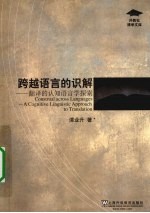图书介绍
跨越语言的识解 翻译的认知语言学探索PDF|Epub|txt|kindle电子书版本网盘下载

- 谭业升著 著
- 出版社: 上海:上海外语教育出版社
- ISBN:9787544613712
- 出版时间:2009
- 标注页数:222页
- 文件大小:12MB
- 文件页数:238页
- 主题词:翻译-认知科学:语言学-研究
PDF下载
下载说明
跨越语言的识解 翻译的认知语言学探索PDF格式电子书版下载
下载的文件为RAR压缩包。需要使用解压软件进行解压得到PDF格式图书。建议使用BT下载工具Free Download Manager进行下载,简称FDM(免费,没有广告,支持多平台)。本站资源全部打包为BT种子。所以需要使用专业的BT下载软件进行下载。如BitComet qBittorrent uTorrent等BT下载工具。迅雷目前由于本站不是热门资源。不推荐使用!后期资源热门了。安装了迅雷也可以迅雷进行下载!
(文件页数 要大于 标注页数,上中下等多册电子书除外)
注意:本站所有压缩包均有解压码: 点击下载压缩包解压工具
图书目录
Chapter 1 Introduction and Overview1
Chapter 2 Toward a Cognitive Model of Meaning Construction in Translation11
2.1 Introduction11
2.2 Two Cognitive Constructivist Approaches to Translation12
2.2.1 The Relevance theory of translation12
2.2.2 A Schema-theoretic view of translation16
2.2.3 Correlation between the Relevance theory of translation and the Schema-theoretic view of translation22
2.2.4 An explanatory frame:Three cognitive principles governing translation in a sequence of priority24
2.3 A Cognitive Linguistic View of Meaning Construction and Translation27
2.3.1 What is cognitive linguistics?27
2.3.2 The interaction between language and cognition in meaning construction in translation32
2.3.3 Language schemata redefined and the sanctioning effects of linguistic conventions in translation36
2.3.4 On-line construal in language use and translation40
2.4 A Cognitive Model of Meaning Construction in Translation43
Chapter 3 Domain Conceptualization and Ground Construal in Translation49
3.1 Domain Conceptualization and Ground Construal49
3.1.1 Cognitive domains50
3.1.2 Ground52
3.2 Construal and Cognitive Abilities52
3.3 Image Transformations/Construal Shifts in Meaning Construction and the lmplications for Translation54
3.4 The Methodology of Investigating Translational Shifts and Variations59
3.4.1 Descriptive Translation Studies vs.Prescriptive Translation Studies59
3.4.2 Comparative analytical method of the DTS61
3.5 Translational Shifts and Variations along Different Dimensions of Construal66
3.5.1 Base/profile organization66
3.5.2 Level of specificity(abstraction)71
3.5.3 Subjectivity vs.objectivity74
3.5.4 Perspective78
3.5.5 Prominence:figure/ground organization90
3.5.6 Interaction between different construal operations93
3.6 Summary94
Chapter 4 Image Schematic,Metonymic and Metaphorical Construal in Translation97
4.1 Image Schema and Image Schematic Transformations in Translation98
4.2 Metonymic Construal in Translation101
4.2.1 Atraditional view of metonymy and metonymy translation101
4.2.2 Metonymy in cognitive linguistics and in translation104
4.2.3 Interim summary118
4.3 Metaphorical Construal in Translation119
4.3.1 A brief review of metaphor translation study in the past119
4.3.2 A cognitive linguistic view of metaphor and metaphor translation122
Case study 1:Strategies ofemotional metaphor translation126
Case study 2:The systematic use of heart metaphors in Scarlet Letter and its Chinese translation136
4.4 Summary150
Chapter 5 Language Schemata,Preferred Construal Patterns,and Cognitive Changes in Translation152
5.1 Language Schemata and Preferred Construal Patterns152
5.2 Image-Schema-Based Preferred Construal Patterns154
5.3 Figure/Ground Construal and Animacy160
5.4 The Sanctioning Effects of Preferred Construal Patterns in Translation165
Chapter 6 Cognitive Styles of Translation168
6.1 Introduction:A Formula of Cognitive Style168
6.2 The Coherence of Construal Operations in Fu Donghua's Translation ofGone with the Wind169
6.3 Metaphoncal Coherence in Tess ofthe D'Urbervilles and Its Translation174
6.4 The Cognitive Styles of Pound and Yip's Chinese Poetry Translation178
6.4.1 A critical review on the syntactic analysis of classical Chinese poetry and its translation179
6.4.2 Pound and Yip's aesthetics of Chinese poetry and its translation182
6.4.3 The correlation between Pound and Yip's aesthetic principles and construal operations186
6.4.4 The preferred construal configuration of Chinese poetics and Pound and Yip's cognitive styles of Chinese poetry translation193
6.4.5 The transplanting issue198
6.5 Conclusion201
Chapter 7 Conclusion204
7.1 Major Findings204
7.2 Limitations and Directions for Future Study205
Bibliography209
Appendix:A glossary in Engish and Chinese218